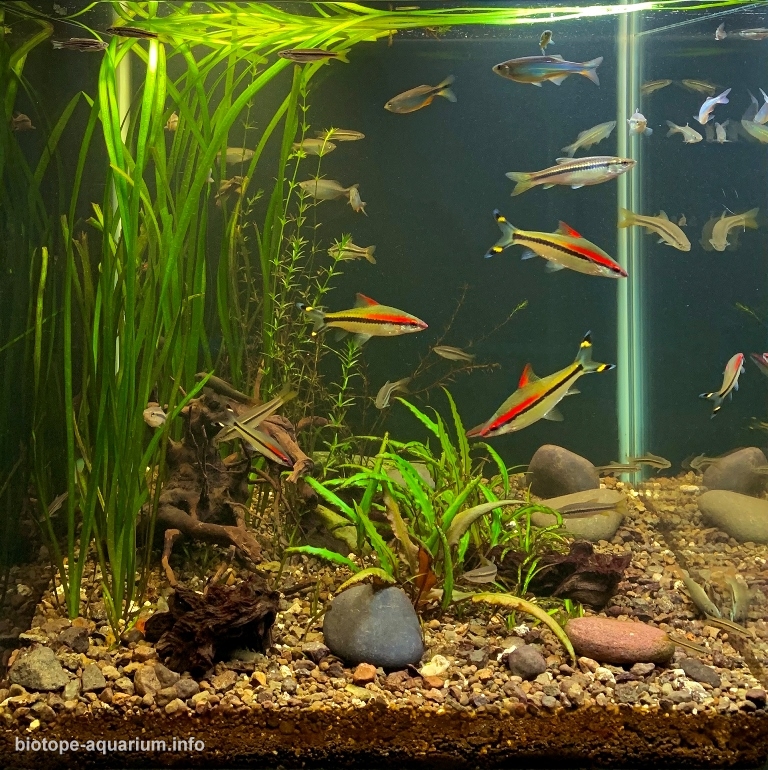Rocky pool with thick riparian vegetation, Chaliyar River, Kerala, India
_th place in Biotope Aquarium Design Contest 2020

Volume: 216 litres
Dimensions: 60 cm X 60 cm X 60 cm
List of fishes:
Sahyadria denisonii (Focal Species, Shoaling species in upper and midwater)
Rasbora daniconius (Shoaling species in upper and midwater)
Rasbora labiosa (Shoaling species in upper and midwater)
Devario malabaricus (Shoaling species in upper and midwater)
Devario aequipinnatus (Shoaling species in upper and midwater)
Garra mullya (Algae eater occupying mostly bottom and sometimes midde water)
Schistura denisoni (Loaches occupying bottom of the tank)
List of plants:
Vallisneria spiralis
Hydrilla verticillate
Cryptocoryne spiralis
Description of decorations:
Tropica Aquarium Soil 18 Litres
Pebbles and small gravel collected from rivers in the Western Ghats similar to the original habitat
Rounded water-warned rocks collected from rivers in the Western Ghats similar to the original habitat
Driftwood
Catappa (Terminalia catappa) Leaves collected from wild
Description of equipment:
EHIEM 2215 Classic Canister Filter
Sponge Filter with Powerhead for surface agitation and extra filtration
Wooden and Metal Mesh Aquarium lead (DIY)
3 LED lights of 22Watts each, Daylight colour
Water parameters:
Temperature: 18-25°C (Seasonal variation is very apparent. Temperatures gradually decrease from July to February and then gradually increase from March to June)
Water Colour: Transparent with mild yellowish tint
pH: 6.8-7.2
TDS: 100 – 120 ppm
Additional info:
I use Reverse Osmosis water to create the pristine water quality (<TDS 150) which is present in the natural habitat of this biotope.
During monsoon I also use rain water up to 70% volume of the tank.
Fishes are fed on variety of pellets and live foods.
Lights are kept on for 8hrs/day
Optimum sunlight falls on tank for 1-2 hrs everyday between 5:00 pm to 6:30pm
Weekly water change: 40%
Cooling fan used from March to May end
Weekly addition of plant micronutrients at the time of water change.
INFORMATION ABOUT BIOTOPE:
Description of the area surrounding the biotope: Chaliyar is the fourth-longest river in Kerala at 169 km in length. The river originates at an elevation of 2066 m. above M.S.L. in the Western Ghats and flows westwards, commanding a drainage area of 2923 Sq. Km. It is bound by latitudes 11.10194444 N and 11.55972222 N and longitudes 75.81250000 E and 76.55000000 E . It flows through one of the most biodiverse regions of the Western Ghats known as the Nigiri Biosphere Reserve. The upper catchment is predominantly evergreen forest and shola grasslands.
Description of the underwater landscape of the biotope: The rocky pools formed in the Nigiri Biosphere Reserve have pristine, highly-oxygenated, crystal clear water with dense riparian vegetation. The substrate consists of small pebbles (10-15mm diameter) to big rounded water worn rocks, leaf litter, driftwood and dense submerged and immersed vegetation on the fringes.
Description of the parameters of the habitat: pH range: 6.8 – 7.8
dH range: 5 – 25
TDS: 100 – 180 ppm
Climate: Subtropical 15°C – 25°C
List of fishes and invertebrates occurring in the nature biotope: The key fish species of this biotope is Sahyadria denisonii (Day, 1865). It is highly endemic and a globally threatened (Listed as Endangered by IUCN) species. Commonly seen species associated with this habitat are Dawkinsia filamentosa (Valenciennes, 1844), Rasbora daniconius (Hamilton, 1822), Rasbora labiosa (Mukerji, 1935), Devario aequipinnatus (McClelland, 1839), Devario malabaricus (Jerdon, 1849), Garra mullya (Sykes, 1839), Schistura denisoni (Day, 1867) etc.
The Western Ghats region is home to 49 species and six sub‐species of caridean shrimps (69% endemism) in four genera and two families, and 39 species of gecarcinucid crabs (92% endemism) in 14 genera. This diversity is probably an underestimate given the lack of biotic surveys and taxonomic research carried out on these groups. The habitat is also home to wide variety of amphibians and reptiles. Many of which are endemic and globally threatened species.
List of plants found in the nature biotope: The region has a huge list of endemic plants both terrestrial and aquatic. Over 600 species of aquatic plants occur throughout the Western Ghats and around 10% of them are globally threatened species.
Threats to the ecology: The river which was in a pristine condition before 6 to 7 decades has become highly degraded in the lower stretches by the effluents of industries and in the upper stretches by various anthropogenic factors like deforestation, rubber and teak plantation, excessive sand mining, high siltation, dynamite fishing and use of copper sulphate for fishing.
Sources of information: https://www.fishbase.in/
https://www.seriouslyfish.com/
https://onlinelibrary.wiley.
https://dennerle.com/en/
“Ornamental Fishes of the Western Ghats of India”, T.V. Anna Mercy, A.Gopalakrishnan, D.Kapoor & W.S. Lakra. National Bureau of Fish Genetic Resources. Lucknow. U.P., India.
Lal Mohan. R.S. and Rema Dev i. K.. 2000. Fish fauna of the Chaliyar River. North Kerala. pp. 155-156. In : Ponniah. A.G. and Gopalakrishnan, A. (Eds.). Endemic Fish Diversity of Western Ghats. NBFGR – NATP Publication – 1,347 p. National Bureau of Fish Genetic Resources. Lucknow. U.P., India.
“Evolution of Chaliyar River Drainage Basin Insights from Tectonic Geomorphology” (PDF). Cochin University of Science and Technology. pp. 8–11. Retrieved 25 March 2014.
